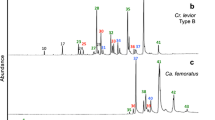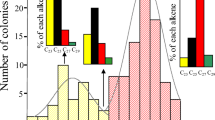Abstract
The cuticular hydrocarbons ofFormica selysi (Formicinae) andMonica rubida (Myrmicinae) reared in single species and in mixed species colonies were determined using gas chromatography (GC) and GC-mass spectrometry. In colonies containing both species, each species modified its species-specific recognition odor. This odor is composed, at least partly, of cuticular hydrocarbons. The cuticular hydrocarbons ofM. rubida consist only of saturated alkanes (n-alkanes and branched alkanes). InF. selysi the mixture also contains unsaturated compounds (monoenes and dienes). In hetero-specific colonies, a new chemical signature developed. This signature resulted from qualitative and quantitative changes in the spectrum of hydrocarbons produced by each species and permitted the two species to inhabit the same nest without displaying interspecific aggression. The readjustment seemed to be more an active synthesis or an active transfer than simply a passive transfer from one species to the other. This may imply that the ants synthesized some components of the hydrocarbon signature of the other species. These synthesizing processes may be activated under particular social environmental conditions.
Similar content being viewed by others
References
Bagnères, A.G., andMorgan, E.D., 1991. The postpharyngeal glands and the cuticule of Formicidae contain the same characteristic hydrocarbons.Experientia 47:106–111.
Bagnères, A.G., Lange, C., Clement, J.L., andJoulie, C. 1988. Les hydrocarbures cuticulaires desReticulitermes français: Variations specifiques et coloniales.Actes Colloq. Insectes Soc. 4:34–42.
Bonavita-Cougourdan, A., Clément, J.L., andLange, C. 1987. Nestmate recognition: The role of cuticular hydrocarbons in the antCamponotus vagus (scop).J. Entomol. Sci. 22:1–10.
Bonavita-Cougourdan, A., Clément, J.L., andLange, C. 1989. The role of cuticular hydro-carbons in recognition of larvae by workers of the antCamponotus vagus: changes in the chemical signature in response to social environment.Sociobiology 16:49–74.
Carlin, N.F., andHölldobler, B. 1986. The kin recognition system of carpenter ants (Camponotus spp.). I Hierarchical cues in small colonies.Behav. Ecol. Sociobiol. 19:123–134.
Carlin, N.F., andHölldobler, B. 1987. The kin recognition system of carpenter ants (Camponotus spp.). II Larger colonies.Behav. Ecol. Sociobiol. 20:209–217.
Carlson, D.A., Roan, C.S., Yost, R.A., andHector, J. 1989. Dimethyl disulfide derivatives of long chain alkenes, alkadienes, and alkatrienes for gas chromatography/mass spectrometry.Anal. Chem. 61:1564–1571.
Clément, J.L., Lange, C., Blum, M.S., Howard, R.W., andLloyd, M. 1985. Chemosystematique du genreReticulitermes (Isoptères) aux U.S.A. et en Europe.Actes Colloq. Insectes Soc. 2:123–131.
Corbara, B., andErrard, C. 1989. Organisation spatiale deMonica rubida etFormica selysi en colonies homo-et hétérospécifiques. Corrélation avec l'organisation sociale.Actes Colloq. Insectes Soc. 5:233–241.
Corbara, B., andErrard, C. 1991. The organisation of artificial heterospecific ant colonies. The case ofMonica rubida/Formica selysi (Myrmicidae, Formicidae) association: Mixed Colony or parallel colonies.Behav. Proc. 23:75–87.
Errard, C. 1986. Role of early experience in mixed colony odor-recognition in the antsMonica ubida andFormica selysi.Ethology 72:243–249.
Errard, C. 1987. Phylogenus/biotope interactions among Formicidae.Behav. Proc. 14:35–47.
Errard, C., andJaisson, P. 1985. Etude des relations sociales dans les colonies mixtes hétéro-spécifiques chez les fourmis.Folia Entomol. Mex. 61:87–98.
Errard, C., andJallon, J.M. 1987. An investigation of the development of the chemical factors in ants intra-society recognition, p. 478,in H. Rembold and J. Eder (eds.). Chemistry and Biology of Social Insects. Verlag J. Pepemy, München.
Fielde, A. 1903. Artificial mixed nests of ants.Biol. Bull. Marine Biol. Lab. 5:320–325.
Francis, G.W. 1981. Alkylthiolation for the determination of double-bond position in unsaturated fatty acid esters.Chem. Phys. Lipid J. Chromatogr. 29:369–374.
Francis, G.W., andVeland, K. 1981. Alkylthiolation for the determination of double-bond positions in linear alkenes.J. Chromatogr. 219:379–384.
Haverty, M.I., Page, M., Nelson, L.J., andBlomquist, G.J. 1988. Cuticular hydrocarbons of dampwood termites,Zootermopsis: Intra- and intercolony variation and potential as taxonomic characters.J. Chem. Ecol. 14:1035–1058.
Hölldobler, B., andMichener, C.D. 1980. Mechanisms of identification and discrimination in social Hymenoptera, pp. 35–56,in H. Markl (ed.). Evolution of Social Behavior: Hypotheses and Empirical Tests. Dahlem Konferenzen, Verlag Chemie, Weinheim.
Howard, R.W., andBlomquist, G.J. 1982. Chemical ecology and biochemistry of insects hydro-carbons.Annu. Rev. Entomol. 27:149–170.
Howard, R.W., McDaniel, C.A., andBlomquist, G.J. 1978. Cuticular hydrocarbons of the eastern subterranean termite,Reticulitermes flavipes (Kollar) (Isoptera: Rhinotermitidae).J. Chem. Ecol. 4:233–245.
Howard, R.W., McDaniel, C.A., andBlomquist, G.J. 1980. Chemical mimicry as an integrating mechanism: Cuticular hydrocarbons of a termitophile and its host.Science 210:431–433.
Howard, R.W., McDaniel, C.A., Nelson, D.R., Blomquist, G.J., Gelbaum, L.T., andZalkow, L.H. 1982. Cuticular hydrocarbons ofReticulitermes virginicus (Banks) and their role as potential species and caste recognition cues.J. Chem. Ecol. 8:1227–1239.
Howard, R.W., Stanley-Samuelson, D.W., andAkre, R.D. 1990. Biosynthesis and chemical mimicry of cuticular hydrocarbons from the obligate predator,Microdon albicomatus Novak (Diptera: Syrphidae) and its ant prey,Myrmica incompleta Provancher (Hymenoptera: Formicidae).J. Kans. Entomol. Soc. 63:437–443.
Jaisson, P. 1980. Environmental preference induced experimentally in ants (Hymenoptera: Formicidae).Nature 286:388–389.
Lemaire, M., Lange, C., Lefebvre, J., andClément, J.L. 1986. Stratégie de camouflage du prédateurHypoponera eduardi dans les sociétés deReticulitermes européens.Actes Colloq. Insectes Soc. 3:97–101.
Morel, L., andVander Meer, R.K. 1988. Ontogeny of nestmate recognition cues in the red carpenter ant (Camponotus floridanus).Behav. Ecol. Sociobiol. 22:175–183.
Nowbahari, E., Lenoir, A., Clément, J.L., Lange, C., Bagnères, A.G., andJoulie, C. 1989. Individual, geographical and experimental variation of cuticular hydrocarbons of the antCataglyphis cursor (Hymenoptera, Formicidae).Biochem. Syst. Ecol. 18:63–74.
Ross, K.G., Vander Meer, R.K., Fletcher, D.J.C., andVargo, E.L. 1987. Biochemical phenotypic and genetic studies of two introduced fire ants and their hybrid (Hymenoptera: Formicidae).Evolution 41:280–293.
Stumper, R. 1950. Etudes myrmecologiques. La myrmecobiose.Bull. Soc. Nat. Luxembourg 44:31–43.
Vander Meer, R.K., andWojcik, D.P. 1982. Chemical mimicry in the myrmecophilous beetleMyrmecaphodius excavaticollis.Science 218:806–808.
Vander Meer, R.K., Lofgren, G.S., andAlvarez, F.M. 1985. Biochemical evidence for hybridization in fire ants.Fla. Entomol. 68:501–506.
Wilson, E.O. 1971. The Insect Societies. Belknap Press of Harvard University Press, Cambridge, Massachusetts.
Author information
Authors and Affiliations
Rights and permissions
About this article
Cite this article
Bagneres, A.G., Errard, C., Mulheim, C. et al. Induced mimicry of colony odors in ants. J Chem Ecol 17, 1641–1664 (1991). https://doi.org/10.1007/BF00984695
Received:
Accepted:
Issue Date:
DOI: https://doi.org/10.1007/BF00984695




